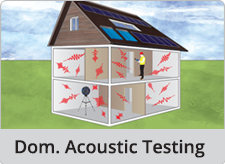Offices Nationwide

Good Hearing?
A typical person with good hearing can hear from about 20Hz to 20kHz (the audio bandwidth). A person's voice will usually range from 500Hz to 2kHz...more

Sound Levels
Decibels (dB) are most commonly used as a measure of sound level, but they are also used in electronics, signals and communications...more
Market Harborough - Room Integrity Testing - 0121 381 0129
The office that covers this area is: Birmingham
Phone Number: 0121 381 0129 Email: market-harborough@e2consultants.co.uk
Room_Integrity_Testing is sometimes referred to as Room Testing, Room Integrity Testing.
What is A Room Integrity Test and How Does It Work?
Room Integrity Testing is required for any gaseous fire suppression system. Gas fire suppression systems work by releasing a gas agent into an enclosure and the gas then either reacts with the fire or reduces the oxygen level which then suppresses or extinguishes the fire. For a fire suppression system to work correctly the enclosure needs to hold the gas for a set period of time.
Room Integrity Testing is used to determine if the room is capable of holding the gas from the fire suppression system successfully. On top of which, the test can predict how long it will take for the gas levels to be reduced to the point where a discharge of the system will be needed. Discharging a fire system can be both costly and disruptive.
Can I Stil Work During The Test?
Yes - people can still work in the room during the test and the equipment will not affect the room. However, with door fan test equipment it's fixed to the frame for the during of the test that will prevent people from leaving and entering the room from when it's sealed in place until the end of the test.
The Procedure
Upon arriving at site and unloading the equipment, one of our consultants will inspect the room where the test will take place. Room measurements will need to be taken at this time if they have not been done prior to our site visit. The door fan kit will be set-up by our consultant in the most appropriate door in the room, usually the main door. There will be no requirement for the removal of any doors to make room for our testing equipment as we aim to make as little impact on the environment as possible.
Standards and Guidance
BSEN15004, ISO14520, BAFE SP203-3 and NFPA 2001 are the main standards when commissioning a system for Room Integrity Testing or for an annual re-test. They're a guidance on how to carry out this sort of test as well as the frequency needed for retesting both Nationally and Internationally across the UK and USA.
Upon setting the equipment up this is the point where nobody can enter or leave this room. Normal work may resume within the room. The consultant on site will now begin to start the fans. The test will depressurise and pressurise the room with computer software generating data to collect.
Upon completion our consultant will check the data against target data provided by our client. If the target is not met our consultants will then begin to diagnose problem areas.
Our consultants are trained to use thermographic cameras to identify leakage areas; these images will be sent to a client with a report. A snag list details leakage areas to be addressed along with pictures of these problem areas. Again, this will be presented to the client with the data report.
How Often Should I Test the Room?
Any room, particularly Electronic Data Processing rooms, often get disturbed by building service work and general building work. Should a small hole be made in the enclosure, or the room size changes, then a retest of the room integrity is required. British Standards recommend that Room Integrity Testing is carried out at least annually to ensure your gaseous fire suppression system will work correctly.


Copyright 2025 E2 Specialist Consultants Limited
Company No. 06728970









































